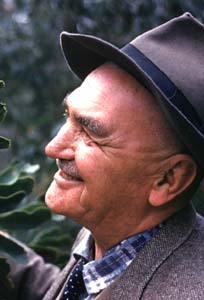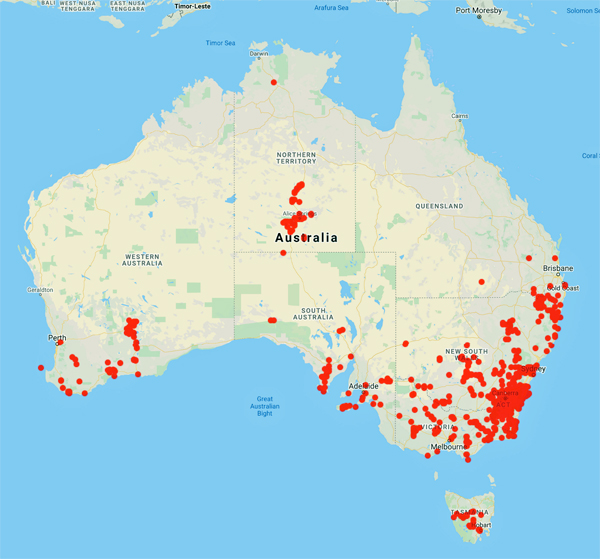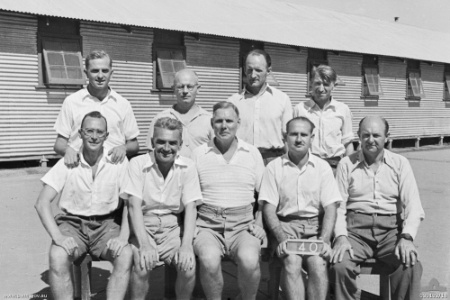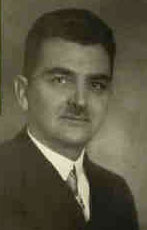
Council of Heads of Australasian Herbaria
Australian National Herbarium
Biographical Notes
 |
Council of Heads of Australasian Herbaria |
 Gauba,
Erwin (1891 - 1964)
Gauba,
Erwin (1891 - 1964)Born in Langenbruck, Austria on 25 November 1891; arrived in Adelaide, South Australia on 19 November 1941; died in Canberra on 7 June 1964.
Graduated in botany in Vienna. Taught French in Alexandria, Egypt. Professor of Botany at the Karaj College of Agriculture (later the Faculty of Agriculture, University of Tehran) until 1940s. Established the first modern herbarium in Iran and helped to develop the College's botanic gardens. Captured with his family by the Allies on 18 September 1941 and interned. Put on a prisoner of war ship to South Africa but diverted to Australia. He arrived in Adelaide on 19 November 1941 on board the New Zealand troop ship Rangitiki and was interned at Loveday (near Renmark, SA) in the mallee where he started collecting herbarium specimens in 1941 (first specimen 20 November 1941). Transferred to Tatura Camp near Shepparton, Victoria on 31 January 1945 and released in Melbourne on 17 September 1946. After the war his wife and daughter were repatriated to France and then Austria, but Gauba acquired British nationality by naturalisation on 10 May 1948 while employed as a gardener at the town of Research in the Dandenongs near Eltham, Victoria.
He moved to Canberra, Australian Capital Territory, became a close research associate of L.D.Pryor, and was appointed (Temporary) Botanist for the Department of Interior in 1950, mainly for the Canberra Botanic Gardens (later Australian National Botanic Gardens). His wife and daughter rejoined him in Canberra. He and Pryor amassed a substantial herbarium, much of which was later transferred to the Canberra University College (later Australian National University, GAUBA). >700 specimens remained in CBG, and these are now in CANB. Gauba left the Department of Interior to join Pryor at the University as a part-time lecturer in 1960.
(More photos at foot of this page.)
Sources:
Personal communication from L.D.Pryor to Murray Fagg, 25 September 1987
A.E.Orchard (1999) A History of Systematic Botany in Australia,
in Flora of Australia Vol.1, 2nd ed., ABRS. [consult for source
references]
H.W.Lack (2000), Karl Heinz Rechinger— a life for botany. Flora Mediterranea 10: 11–64.
National Archives of Australia: Prisoners of War and Internees Information Bureau - Directorate of Prisoners of War and Internees; MP1103/1, Registers containing 'Service and Casualty' forms (Form A112) of enemy prisoners of war and internees held in camps in Australia, 1939–1947; R36476, Prisoner of War/Internee: Gauba, Erwin; Date of birth - 25 November 1891; Nationality - German, 1941–1946.
National Archives of Australia: Department of Immigration, Victorian Branch; B78, Alien registration documents, 1948–1965; 1948/GAUBA E, GAUBA Erwin - Nationality: Austrian - Arrived Adelaide per Rangitiki 19 November 1941, 1948–1948.
Family Notices: Deaths, Canberra Times, Monday 8 June 1964, p. 18.
Data from 5,712 specimens


Australian War Memorial Photo 030192/18:
Loveday, South Australia. 16 March 1943.
Group of German internees apprehended in Australia now interned at No. 14 (10?) Prisoner of War and Internee Group.
Back row, left to right: R36767 Henri Schubert; R36677 Rudolf Ortel; A. Skiba; S. Bechert.
Front row: R36623 Hans Leiberfried; R36476 Dr Erwin Gauba; P35896 Franz Friedrich Ewald Kleine; R. Kraus; G. Kabus.
Note: The number is an assigned POW number. Prefix R indicates apprehended by the British Military Forces in Iran; Prefix P indicates apprehended in Palestine.

Photo of younger Gauba from Naturalisation papers held in National Archives of Australia